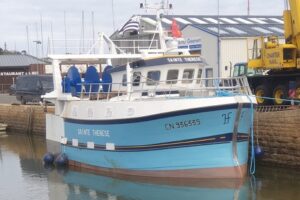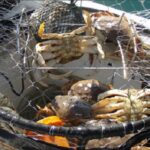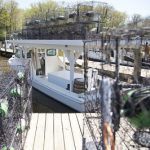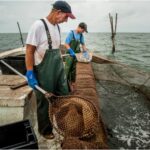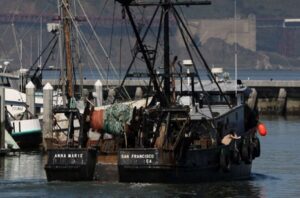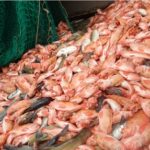Tag Archives: invasive species
Lake Manitoba Commercial Fishing In Jeopardy
The local commercial fishing industry is being threatened by the  into Lake Manitoba. Fishermen have noticed more jackfish, also known as northern pike, since water from the Assiniboine River was diverted into Lake Manitoba during the flood of 2011. Perry Gaudry’s a commercial ice fisherman, and says the increased population is starting to reduce the population of the other fish. Read the rest here 12:27
into Lake Manitoba. Fishermen have noticed more jackfish, also known as northern pike, since water from the Assiniboine River was diverted into Lake Manitoba during the flood of 2011. Perry Gaudry’s a commercial ice fisherman, and says the increased population is starting to reduce the population of the other fish. Read the rest here 12:27
Great Lakes fishery managers need insight on climate change impacts
 Great Lakes fishery managers worry that their operations may be harmed by invasive species, habitat loss in the long run, according to a new study. Read the rest here 08:52
Great Lakes fishery managers worry that their operations may be harmed by invasive species, habitat loss in the long run, according to a new study. Read the rest here 08:52
No profits found in this tangled catch – Fishermen taking a beating!
 Local fishermen this year have had a tough time with a species of red seaweed, an algae, that looks like matted hair. The algae began to bloom and spread in May. Nets would get fouled – often beyond recognition – and the fishermen would spend hours cleaning them, only to have their nets get “weeded up” on the very next tide. And to add insult to injury, when the weed was thickest, covering acres of the seabed, the nets would often be empty of fish. Read the rest here 13:23
Local fishermen this year have had a tough time with a species of red seaweed, an algae, that looks like matted hair. The algae began to bloom and spread in May. Nets would get fouled – often beyond recognition – and the fishermen would spend hours cleaning them, only to have their nets get “weeded up” on the very next tide. And to add insult to injury, when the weed was thickest, covering acres of the seabed, the nets would often be empty of fish. Read the rest here 13:23
Green Crab found near Pool’s Cove – Could be a serious issue in Fortune Bay
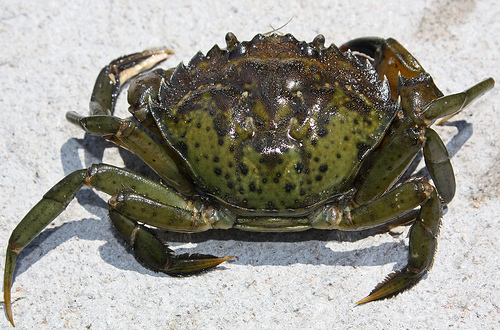 According to Cynthia McKenzie, a research scientist with Fisheries and Oceans, the green crab has established a foothold in the Pool’s Cove area of Fortune Bay. She said DFO issued experimental licenses to the Conne River Band and a group in Pool’s Cove this past summer to catch green crab. Read the rest here 09:59
According to Cynthia McKenzie, a research scientist with Fisheries and Oceans, the green crab has established a foothold in the Pool’s Cove area of Fortune Bay. She said DFO issued experimental licenses to the Conne River Band and a group in Pool’s Cove this past summer to catch green crab. Read the rest here 09:59
Lime does not harm lobsters or other marine life, study shows
 Tunicate are an invasive species that are a serious threat to the mussel industry. Tunicate attach themselves to mussel socks, completely covering them and making it difficult for the mussels to feed. Lime is used in the mussel industry to remove tunicate from the lines. Lime is also used in the oyster fishery, mainly to remove starfish. Read the rest here 08:04
Tunicate are an invasive species that are a serious threat to the mussel industry. Tunicate attach themselves to mussel socks, completely covering them and making it difficult for the mussels to feed. Lime is used in the mussel industry to remove tunicate from the lines. Lime is also used in the oyster fishery, mainly to remove starfish. Read the rest here 08:04
Portland Press: Our View: Public-private partnership critical to kicking green crab out of Maine
Given how high the stakes are for the state’s marine habitat and its third-largest commercial fishery, Maine has to focus on removing green crabs from coastal waters as quickly as possible. As state marine ecology researcher Brian Beal told the Press Herald in February: “How do you get rid of an invasive species? You fish ‘em to death. We did an awful good job of reducing the population of sea urchins without even trying.” Read more here 10:17
Blue and Flathead Catfish Invade the Chesapeake Bay – No wonder prefered stocks are in trouble!
 Initially introduced for sport fishing in several Virginia tributaries in the 1960s to 1980s, blue and flathead catfish are now considered invasive in the Chesapeake Bay have , and they are now present in every major Chesapeake Bay tributary. Read more here 11:36
Initially introduced for sport fishing in several Virginia tributaries in the 1960s to 1980s, blue and flathead catfish are now considered invasive in the Chesapeake Bay have , and they are now present in every major Chesapeake Bay tributary. Read more here 11:36
Can US eliminate invasive species by eating them?
HOUSTON (AP) – It seems like a simple proposition: American lakes, rivers and offshore waters are filling up with destructive fish and crustaceans originally from other parts of the world, many of them potential sources of food. So why not control these invasive populations by getting people to eat them? Read more here 13:16
The Great Sea Urchin Crisis – “They’re completely dying off,”
 Tye Zinck chips the ice off his scuba mask, yells a warrior cry and lunges off the boat. Until he can slow his gasping, he floats atop the 40 degree water, the wind of Sambro Cove, Nove Scotia, biting at his ears. The seams of his dry suit are so thick that it looks inside out. Read more here 11:56
Tye Zinck chips the ice off his scuba mask, yells a warrior cry and lunges off the boat. Until he can slow his gasping, he floats atop the 40 degree water, the wind of Sambro Cove, Nove Scotia, biting at his ears. The seams of his dry suit are so thick that it looks inside out. Read more here 11:56
The hungry critter’s first dish was mussels. Then scallops. Now it’s soft-shell clams. Voracious Invasive Crab Threatening Maine’s Shellfish Industry

And some fear lobsters will be next. European green crabs are devouring a shellfish buffet along Maine’s seashore, plundering populations in their wake. To get a snapshot of just how severe the problem is, clammers, scientists, and marine officials took a survey today along Maine’s coast. Patty Wight joined them in Freeport. listen@mpbn Green Crab and Sculpin Sam Fisheries Broadcast 12:00
Snakeheads break out of Potomac, enter Rappahannock River
 Richmond Times-Dispatch – The northern snakehead, an invasive species of fish native to Asia, has successfully broken out of the Potomac River system and established itself in the Rappahannock River, according to state officials. The fish drew headlines when it turned up in a Maryland pond in 2002, in part because of its prodigious teeth and ability to survive several days out of water by breathing air. Spotted less than a decade ago in the Potomac, the snakehead has not just survived, but spread. continued
Richmond Times-Dispatch – The northern snakehead, an invasive species of fish native to Asia, has successfully broken out of the Potomac River system and established itself in the Rappahannock River, according to state officials. The fish drew headlines when it turned up in a Maryland pond in 2002, in part because of its prodigious teeth and ability to survive several days out of water by breathing air. Spotted less than a decade ago in the Potomac, the snakehead has not just survived, but spread. continued
State senator’s bill aims to reel in ‘rotten invasive’ sea lamprey
 A bill circulated by a Republican lawmaker aims to control sea lamprey — eel-like parasites that look like monsters, attack trout and other fish, and could suck the lifeblood out of the Great Lakes ecosystem. The toothy invasive species threatens the commercial and recreational fisheries and tourism industry, said the bill’s sponsor, Sen. Robert Cowles, R-Green Bay. continue reading
A bill circulated by a Republican lawmaker aims to control sea lamprey — eel-like parasites that look like monsters, attack trout and other fish, and could suck the lifeblood out of the Great Lakes ecosystem. The toothy invasive species threatens the commercial and recreational fisheries and tourism industry, said the bill’s sponsor, Sen. Robert Cowles, R-Green Bay. continue reading





































